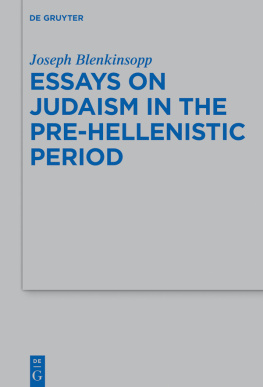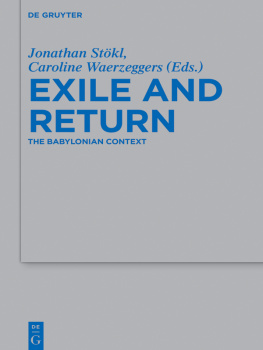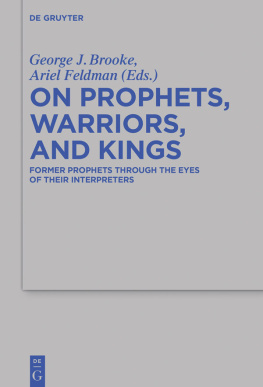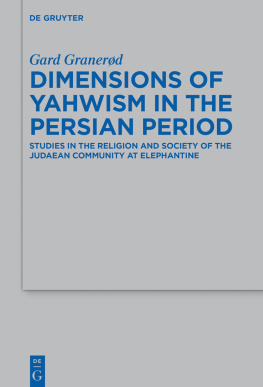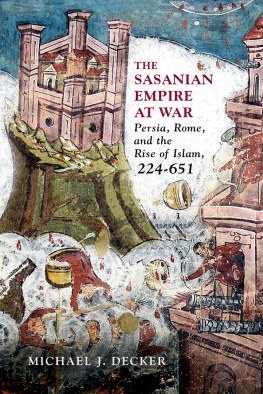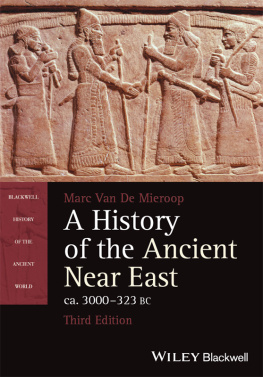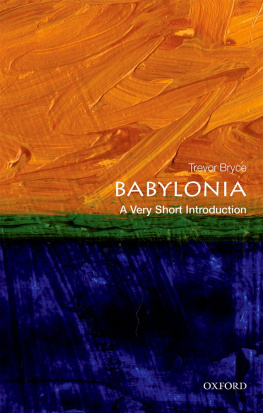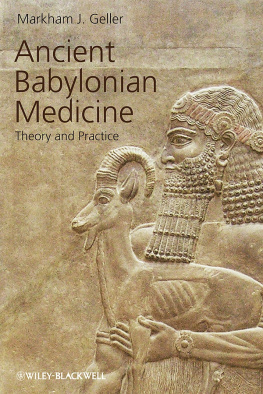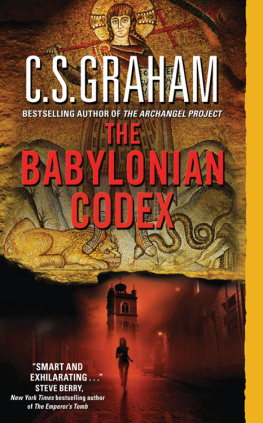Overview
Guide

Joseph Blenkinsopp
Essays on Judaism in the Pre-Hellenistic Period
Beihefte zur Zeitschrift fr die alttestamentliche Wissenschaft

Edited by
John Barton, Reinhard G. Kratz, Nathan MacDonald, Carol A. Newsom and Markus Witte
Volume 495

ISBN 978-3-11-047514-2
e-ISBN (PDF) 978-3-11-047687-3
e-ISBN (EPUB) 978-3-11-047529-6
ISSN 0934-2575
Library of Congress Cataloging-in-Publication Data
A CIP catalog record for this book has been applied for at the Library of Congress.
Bibliografische Information der Deutschen Nationalbibliothek
The Deutsche Nationalbibliothek lists this publication in the Deutsche Nationalbibliografie; detailed bibliographic data are available in the Internet at http://dnb.dnb.de.
2017 Walter de Gruyter GmbH, Berlin/Boston
www.degruyter.com
Foreword
These fifteen essays, either published in different formats over the last three decades or previously unpublished, deal with the earliest phase in the history of the Jewish people from the liquidation of the Judaean state in 586 B.C.E. to the Macedonian conquest in 332 B.C.E. This was an axial period in the history of the Near East and the eastern Mediterranean world in general. It witnessed the end of the great Semitic empires, Assyrian and Babylonian; decisive advances in religion with the appeal to a creator-deity in Deutero-Isaiah, Babylonian Marduk theology, and Zoroastrianism; the rise of what can be called the first world empire with the conquests of the Iranian Cyrus II; the Pre-Socratics and the great age of Greek philosophy, art and science. For the Judaean survivors of the Babylonian conquest and the subsequent deportations living in a post-collapse society there was, as always in such a situation, the issue of continuity with the past, with different groups in the land of Judah and the diaspora claiming possession of the traditions without which no society can continue in existence. This was a situation favourable to the emergence of sectarianism the first indications of which can be traced to these two and a half centuries. With the suppression of the national dynasty and, with it, the apparatus of an independent state, the rebuilt temple became the focus and emblem of national and ethnic identity. The essays deal with different aspects of the religious, intellectual and social history of this crucial period.
It is my pleasure to acknowledge and thank those who gave permission to reprint the following essays:
The Society of Biblical Literature of Atlanta, Georgia, USA for permission to reprint
The Theological Politics of Deutero-Isaiah from A. Lanzi and J. Stkl (eds.), Divination, Politics and Near Eastern Empires (Atlanta: SBL, 2014), 12943.
Was the Pentateuch the constitution of the Jewish ethnos in the Persian period? from J. W. Watts (ed.), Persia and Torah. The Theory of Imperial Authorization of the Pentateuch (Atlanta: SBL, 2001), 4162.
The Catholic Biblical Association and the editor of Catholic Biblical Quarterly for permission to reprint: Deutero-Isaiah and the Creator-Deity: Yahweh, Ahuramazda, Marduk from The Cosmological and Protological Language of Deutero- Isaiah, Catholic Biblical Quarterly 73 (2011), 433510.
Eisenbrauns Publishing House, Winona Lake, Indiana, USA for the following:
Judeans, Jews, Children of Abraham from O. Lipschits, G. N. Knoppers and M. Oeming (eds.), Judah and the Judeans in the Achaemenid Period (Winona Lake, Indiana: Eisenbrauns, 2011), 46182.
Ideology and Utopia in 12 Chronicles from E. Ben Zvi and D. V. Edelman (eds.), What was authoritative for Chronicles? (Winona Lake, Indiana: Eisenbrauns, 2011), 89103.
Jewish Sectarianism from Ezra to the Hasidim from O. Lipschits, G. N. Knoppers, R. Albertz (eds.), Judah and the Judeans in the fourth century B.C.E . (Winona Lake, Indiana: Eisenbrauns, 2007), 385404.
Sheffield Academic Press, Sheffield, UK for Temple and Society in Achaemenid Judah from P. R. Davies (ed.), Second Temple Studies 1 (Sheffield: Sheffield Academic Press, 1991), 2255.
T & T Clark International US, an imprint of Bloomsbury Publishing Inc. for Footnotes to the Rescript of Artaxerxes in Ezra 7:1126 from P. R. Davies and D. V. Edelman (eds.), The Historian and the Bible. Essays in Honour of Lester L. Grabbe (New York & London: T. & T. Clark, 2010), 15058.
Oxford University Press for The Nehemiah Autobiographical Memoir from S. E. Balentine and J. Barton (eds.), Language, Theology and the Bible. Essays in Honour of James Barr (Oxford: Clarendon, 1994), 199212.
The Editor of Biblica , Rome, Italy for The Social Context of the Outsider Woman in Proverbs 19 from the same title in Biblica 72 (1991), 45773.
The editors of Journal for the Study of the Old Testament for The Social Roles of Prophets in Achaemenid Judah from: the same title, Journal for the Study of the Old Testament 93 (2001), 3958.
Koninklijke Brill NV, Leiden, Netherlands for A Case of Benign Imperial Neglect and its Consequences: An Exercize in Virtual History from J. Cheryl Exum (ed.), Virtual History and the Bible (Leiden: Brill, 2000), 12936.
I.The Theological Politics of Deutero-Isaiah
Source: Divination, Politics and Near Eastern Empires , ed. by Alan Lenzi and Jonathan Stkl, 12943. Atlanta: Society of Biblical Literature, 2014.
1Prophecy and Politics
The critical consensus is that the term Deutero-Isaiah or Second Isaiah refers to chapters 4055 of the book of Isaiah, which is taken to be a distinct, anonymous text which, for reasons and under circumstances not entirely clear, came to be attached to chapters 139 which feature a prophet called Isaiah who is referred to in it by name. This historical Isaiah was active in the eighth century BC. during the heyday of the Assyrian empire, while the anonymous author of Isaiah 4055 lived, spoke, and perhaps also wrote two centuries later, during the last years of the Babylonian empire and the rise of the Persian (Iranian, Achaemenid) empire with the conquests of Cyrus II, who is named in Deutero-Isaiah. This would be about the middle of the sixth century BC. which, in the province of Judah, would correspond to the half-century (give or take a year or two) between the fall of Jerusalem to the Babylonians in 586 and the fall of Babylon to the Persians in 539. This period marks one of the great turning points in the history of the ancient world and also of course in the history of Israel, a period which witnessed the end of the great Semitic empires in the Middle East which will reappear only with the Islamic conquests in the seventh century of the common era.
So much for the title Deutero-Isaiah. The term theological politics should not be unfamiliar, since political activity driven by theological convictions is going on around us all the time, not least in the United States. But it is important to add that politics, including international politics, was a fundamental part of the agenda of Israelite prophecy. The prophets were not primarily mystics, and they have little to say about aspects of personal morality, especially those aspects which come under the rubric of sexual ethics which so preoccupy us today. Their focus was on the condition of society and politics, especially international politics. Here, a quote from Max Weber is to the point: It must not be forgotten that in the motivation of Israelite prophets social reforms were only means to an end. The primary concern of prophets was with foreign politics, since they constituted the theatre of their gods activity. the kingdom of Judah: the great issue during that critical period was the decision whether to participate in rebellion against the imperial power of Babylon or accept the status quo and make the best of it; a dilemma common to small nations at all times who are confronted with the overwhelming resources and power of empires and superpowers. Combing through the biblical sources for those years prior to the final catastrophe, we can identify distinct parties opposed to and in favour of rebellion, with prophets on both sides. Jeremiah acted as the spokesman and point person for the party which opposed rebellion the appeasement party as their opponents would have called it and on the other side Hananiah, a Judaean prophet and opponent of Jeremiah who made a short-term (and therefore risky) prediction that the Babylonians would be finished in two years, which did not happen (Jer 28:14). In the Babylonian diaspora two prophets, Ahab and Zedekiah, were put to a horrible death for sedition. They would have been considered martyrs to the cause of resistance in the eyes of their supporters, but were vilified by Jeremiah (Jer 29:2123).

